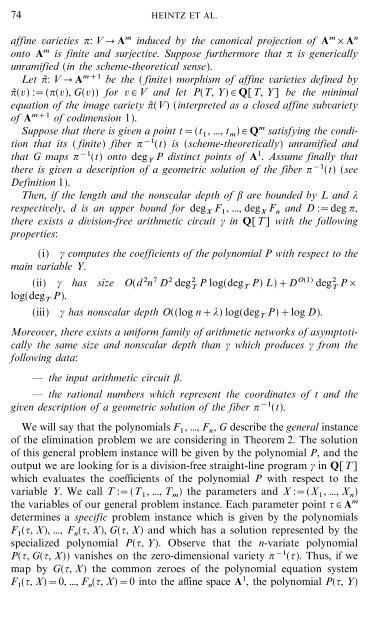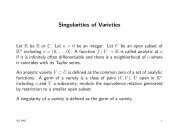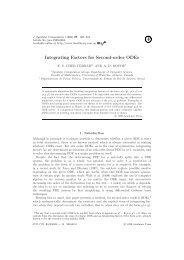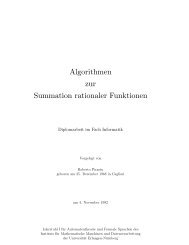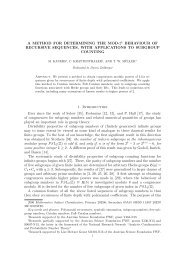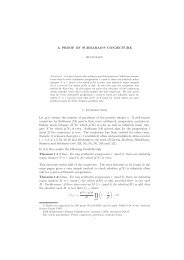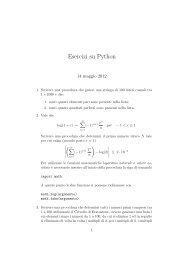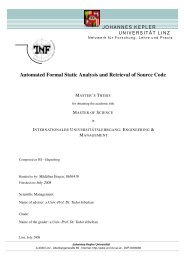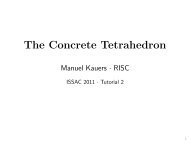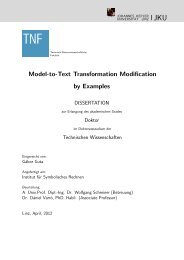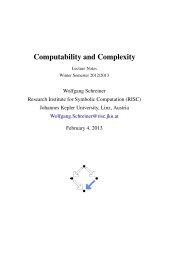Deformation Techniques for Efficient Polynomial Equation ... - RISC
Deformation Techniques for Efficient Polynomial Equation ... - RISC
Deformation Techniques for Efficient Polynomial Equation ... - RISC
You also want an ePaper? Increase the reach of your titles
YUMPU automatically turns print PDFs into web optimized ePapers that Google loves.
74 HEINTZ ET AL.<br />
affine varieties ?: V A m induced by the canonical projection of A m _A n<br />
onto A m is finite and surjective. Suppose furthermore that ? is generically<br />
unramified (in the scheme-theoretical sense).<br />
Let ?~: V A m+1 be the ( finite) morphism of affine varieties defined by<br />
?~(v) :=(?(v), G(v)) <strong>for</strong> v # V and let P(T, Y)#Q[T, Y] be the minimal<br />
equation of the image variety ?~(V) (interpreted as a closed affine subvariety<br />
of A m+1 of codimension 1).<br />
Suppose that there is given a point t=(t 1 , ..., t m )#Q m satisfying the condition<br />
that its ( finite) fiber ? &1 (t) is (scheme-theoretically) unramified and<br />
that G maps ? &1 (t) onto deg Y P distinct points of A 1 . Assume finally that<br />
there is given a description of a geometric solution of the fiber ? &1 (t) (see<br />
Definition 1).<br />
Then, if the length and the nonscalar depth of ; are bounded by L and *<br />
respectively, d is an upper bound <strong>for</strong> deg X F 1 , ..., deg X F n and D :=deg ?,<br />
there exists a division-free arithmetic circuit # in Q[T] with the following<br />
properties:<br />
(i) # computes the coefficients of the polynomial P with respect to the<br />
main variable Y.<br />
(ii) # has size O(d 2 n 7 D 2 deg 2 P log(deg T T P) L)+D O(1) deg 2 P_ T<br />
log(deg T P).<br />
(iii) # has nonscalar depth O((log n+*) log(deg T P)+log D).<br />
Moreover, there exists a uni<strong>for</strong>m family of arithmetic networks of asymptotically<br />
the same size and nonscalar depth than # which produces # from the<br />
following data:<br />
the input arithmetic circuit ;.<br />
the rational numbers which represent the coordinates of t and the<br />
given description of a geometric solution of the fiber ? &1 (t).<br />
We will say that the polynomials F 1 , ..., F n , G describe the general instance<br />
of the elimination problem we are considering in Theorem 2. The solution<br />
of this general problem instance will be given by the polynomial P, and the<br />
output we are looking <strong>for</strong> is a division-free straight-line program # in Q[T]<br />
which evaluates the coefficients of the polynomial P with respect to the<br />
variable Y. We call T :=(T 1 , ..., T m ) the parameters and X :=(X 1 , ..., X n )<br />
the variables of our general problem instance. Each parameter point { # A m<br />
determines a specific problem instance which is given by the polynomials<br />
F 1 ({, X), ..., F n ({, X), G({, X) and which has a solution represented by the<br />
specialized polynomial P({, Y). Observe that the n-variate polynomial<br />
P({, G({, X)) vanishes on the zero-dimensional variety ? &1 ({). Thus, if we<br />
map by G({, X) the common zeroes of the polynomial equation system<br />
F 1 ({, X)=0, ..., F n ({, X)=0 into the affine space A 1 , the polynomial P({, Y)


